O principal aspeto da renovação é o acabamento das paredes da cozinha. É necessário escolher materiais de acabamento práticos e bonitos, e não é fácil: nem todos cumprem os requisitos.
Conteúdo do artigo
Requisitos para os materiais de acabamento da cozinha
A cozinha refere-se a divisões com condições difíceis: existe frequentemente humidade elevada, vapores, salpicos de gordura. Por conseguinte, os materiais para o acabamento das paredes da cozinha devem ser bem laváveis e não devem reagir à humidade elevada.
Para além de cozinhar, na maioria das famílias, a cozinha é ainda utilizada como sala de jantar. E se assim for, então o acabamento também deve ser bonito. Naturalmente, deve ser seguro para a saúde e, de preferência, durável.

Satisfaz todas as condições sem tantos materiais. Salva apenas uma grande variedade de texturas e cores, e recentemente apareceu novidades. Assim, o acabamento das paredes da cozinha é efectuado com a ajuda de:
- azulejos e mosaicos de cerâmica;
- papel de parede lavável;
- tinta à prova de água;
- Painéis MDF, plástico;
- gesso decorativo.
Devido ao facto de uma divisão combinar diferentes funções, mesmo uma pequena cozinha é dividida em duas zonas - de trabalho e de refeições. E enfatiza a divisão a utilização de diferentes materiais de acabamento, incluindo para as paredes. Por isso, na maioria das vezes, é necessário escolher dois tipos de acabamentos de parede para a cozinha - na zona de trabalho, algo muito prático, fácil de limpar, e na zona de refeições, no mesmo estilo e cor, mas mais acolhedor.
Azulejos e mosaicos de cerâmica
Azulejos de cerâmica para acabamento das paredes da cozinha - uma excelente opção em termos de durabilidade e facilidade de manutenção. Mas se toda a divisão for revestida a azulejos, será desconfortável, como na sala de operações. Outra desvantagem - custos elevados para o próprio material e para a sua instalação: colocar azulejos nas paredes não é muito fácil, por isso mais frequentemente contratar mestres, e seu trabalho não é barato.
Por isso, na reparação moderna, a maior parte das cerâmicas terminou a área de trabalho - o espaço da parede entre o chão e os armários suspensos. Esta peça também é chamada de avental de cozinha. Anteriormente, era feito apenas de azulejos, hoje este material tem concorrentes decentes - painéis de vidro cerâmico e plástico, painéis de MDF, pedra decorativa e natural.
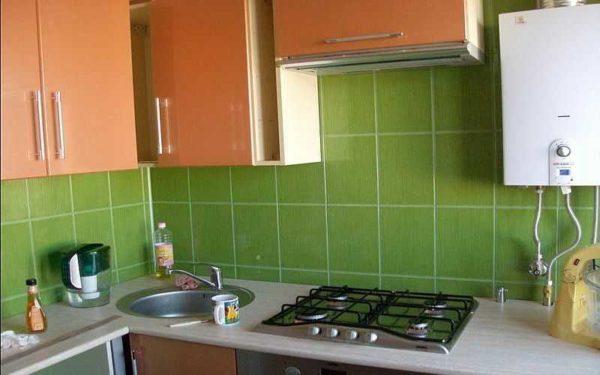
Todos os novos materiais são fáceis de instalar - montados em alguns parafusos, não requerem uma superfície perfeitamente plana da parede. Também é mais fácil cuidar deles, porque as costuras são muito poucas - na junção dos painéis - e podem ser seladas com selante para excluir a humidade e a sujidade. Em geral, os azulejos de cerâmica não são uma má opção para o acabamento da área de trabalho na cozinha, mas não são a única nem a melhor.
Opções de acabamento com ladrilhos cerâmicos
Mas apesar da presença de novos materiais, o azulejo continua a ser a opção mais popular para o acabamento da parede de trabalho na cozinha. Apenas no estilo de decoração existem diferenças significativas. Os omnipresentes azulejos quadrados de tamanho médio 15 * 15 cm ou 18 * 18 cm, anteriormente utilizados, já não são populares. Em favor de grandes formatos - retangulares ou quadrados longos, mas com um lado de pelo menos 35 cm, ou mesmo 50-70 cm. Assim, verifica-se que o avental de cozinha requer uma ou duas filas de azulejos.
O que escolher exatamente para um azulejo - liso, com textura, com imagens ou sem - depende de si. A textura, claro, tem um aspeto muito interessante. Mas, em termos práticos, é inferior a uma superfície lisa: nas reentrâncias, a sujidade e a fuligem entopem. Para a pôr num estado normal, é necessário um esforço considerável.
Acabamento de paredes com mosaico
O acabamento das paredes da cozinha em mosaico é muito bonito. Trata-se de uma cerâmica muito pequena, cerâmica de vidro ou azulejos de vidro, colados numa grelha - para uma instalação mais rápida. Pequenos quadrados podem ser da mesma cor, e pode - diferentes tons na mesma gama, há um mosaico, forrado com padrões e até mesmo pinturas. Este tipo de material de acabamento é ainda mais caro do que a telha cerâmica, mas o seu aspeto não é normal.
Acabar com o mosaico na cozinha não pode ser apenas a parede de trabalho. O mesmo painel é feito sobre a mesa de jantar. Isto harmoniza o interior. Além disso, outra zona frequentemente suja recebe um revestimento facilmente lavável.
Papel de parede: lavável e pintável
Este tipo de material de acabamento é utilizado sobretudo nas paredes da zona de refeições da cozinha. Na área de trabalho, mesmo o papel de parede super-lavável e super-resistente não durará muito tempo. Especialmente na zona do lava-loiça.
De acordo com a tecnologia de acabamento das paredes do papel de parede da cozinha envolve primeiro o nivelamento das paredes, em uma superfície nivelada cola papel de parede. A melhor opção - com revestimento de vinil. O vinil forma uma película densa que pode ser limpa com um pano. Existem tecnologias que permitem obter um revestimento tão durável que esses papéis de parede podem ser lavados com uma escova usando detergentes líquidos (não abrasivos).
O papel de parede em vinil é à base de papel, mas existe em velo. O velo numa superfície plana é colado muito facilmente. Se as paredes da cozinha não estiverem niveladas, é melhor usar papel de parede de vinil numa base de papel, e o papel escolhe um denso, e a superfície do rolo - texturizada. Isso ajudará a esconder irregularidades.
Deverá ser atribuída uma categoria separada ao papel de parede no âmbito da pintura. Também devem ser colados a uma superfície plana. São feitos mais frequentemente com base em telas de fibra de vidro. São pintados com tinta à base de água, sem problemas, podem ser repintados de 3 a 20 vezes (depende do tipo de papel de parede, quanto mais você puder repintar, mais caro será o papel de parede). A escolha da tinta será abordada na secção seguinte.
Outro tipo distinto de papel de parede - papel de parede fotográfico. Paisagens luminosas ou pastorais, imagens de cidades, "naturezas mortas" de cozinha - tudo o que o seu coração desejar. Normalmente, é colado na parede onde se encontra a mesa ou numa parede livre. Há, aliás, uma forma de esbater os limites de uma cozinha retangular - colar uma imagem de grande formato com uma visita à parede vizinha. Altera imediatamente a perceção visual da divisão.
Pintura de paredes
A escolha da tinta para as paredes da cozinha não é assim tão grande - a maior parte das tintas de emulsão aquosa são adequadas, mas é necessário que sejam laváveis. Este tipo de tinta pode ser repintado sem problemas, mas é mais fácil de lavar. Portanto, escolhemos apenas isso.
De acordo com a tecnologia de acabamento das paredes na cozinha, pintar - numa parede nivelada, pré-preparada. O tipo de primário é escolhido em função do tipo de tinta (com acrilatos, alquídicos e silicatos). Após a secagem do primário, a tinta é aplicada em várias camadas. Como a base é aquosa, praticamente não há odor, após a secagem, forma-se uma película de vários graus de resistência (leia mais sobre tintas para acabamento aqui).
O acabamento das paredes da cozinha com tinta pode ser de fundo, escuro ou, pelo contrário, chamar a atenção para si próprio. As tintas de fundo são escolhidas se o conjunto de mobiliário de cozinha for de cores vivas, e as paredes claras são feitas se as fachadas forem neutras.
Reboco decorativo
O gesso decorativo é também designado por "papel de parede líquido". Estas composições são texturadas e lisas. Liso - gesso veneziano à base de pó de mármore com vários aditivos. Ao toque, a superfície torna-se sedosa, tem um brilho muito semelhante ao da seda. Existem dois tipos de gesso texturado. No primeiro, o relevo é obtido devido à presença na composição de algumas grandes inclusões (geralmente areia de quartzo de granularidade diferente), o segundo relevo é obtido devido à aplicação de rolos especiais, escovas, espátulas.
O acabamento das paredes da cozinha com gesso decorativo liso ocorre após o nivelamento cuidadoso das paredes. A composição é muito cara e gastá-la no nivelamento de defeitos é extremamente pouco rentável. Além disso, as mais pequenas irregularidades estragam a impressão geral. O reboco decorativo estrutural pode ser decorado com paredes não ideais - a superfície continuará a ser irregular, pelo que não é necessária uma suavidade perfeita. O que é obrigatório em qualquer caso - pré-preparação para uma melhor aderência à superfície.
O gesso decorativo para acabamento das paredes da cozinha é uma boa escolha - é lavável, por muito tempo mantém sua aparência, muitos pigmentos não desbotam e não queimam. A desvantagem - o alto preço do material e uma técnica complexa de aplicação, com a qual nem todos os "mestres" podem lidar. Para além da capacidade de rebocar aqui requer gosto artístico, e não é toda a gente.
Pedra natural e decorativa
O design não normalizado das paredes da cozinha é feito com a utilização de pedra decorativa natural ou artificial. Natural - serrada em placas finas de diferentes tamanhos e formas. Artificial - feita à base de gesso ou cimento, com a adição de migalhas de minerais naturais. A pedra natural é mais pesada e mais cara, é mais difícil de colocar. A artificial é mais leve, muito mais barata, mais fácil de colocar um lado como ladrilho, o segundo imita a superfície da pedra e a cor e forma.
O acabamento das paredes da cozinha em pedra decorativa - natural ou artificial - requer alguma perícia. Também é necessário nivelar a superfície antes de começar o trabalho de acabamento. Colocar o adesivo para os azulejos, revestindo primeiro com primário. Depois de colocar a pedra, as juntas são expandidas (com argamassa ou argamassa), depois de a parede ser coberta com verniz - para facilitar a manutenção.
Acabamento das paredes da cozinha com painéis de plástico
Se precisar de uma opção económica e rápida para terminar a cozinha, considere os painéis de plástico para paredes. São montados numa ripa, fixados com parafusos auto-roscantes ou agrafos de um agrafador. Não é necessário nivelar as paredes - o sarrafo esconderá todas as falhas. O acabamento das paredes da cozinha com painéis de PVC é provavelmente a forma mais rápida de atualizar a divisão. Para além disso, é a mais barata. As opções de cores são muitas - desde cores sólidas mate ou brilhantes até à imitação de azulejos, madeira e outras superfícies e materiais.
Naturalmente, existem desvantagens - matérias-primas não naturais e fragilidade. As matérias-primas não são naturais, mas em condições normais de funcionamento (não exceder a temperatura) são inofensivas. Com fragilidade. não pode fazer nada - os painéis de plástico têm jumpers entre as duas camadas de polímero. Em caso de impacto, amachucam-se. Existem, no entanto, painéis de parede de PVC finos, mas são colados em paredes planas. Em todo o caso, se precisar de uma forma rápida e económica de atualizar o revestimento da parede da sua cozinha, considere os painéis de plástico.
Painéis MDF
Outra forma fácil e rápida de efetuar reparações é o acabamento das paredes da cozinha com painéis de MDF. Também são montados numa ripa, mas são muito mais caros do que o plástico. Uma maneira de terminar o avental sem azulejos é usar placas de MDF. Além disso, este material pode ser utilizado para decorar o resto das paredes. É feito de resíduos de madeira moída com farinha, que é moldada a alta pressão. As placas resultantes são depois laminadas com uma película. As cores do MDF podem ser muito variadas, mas as mais populares são as imitações de madeira de diferentes espécies e tonalidades.
Existem diferentes soluções de cores para decorar as paredes da cozinha com painéis de MDF:
- Escolha a mesma cor que a da bancada.
- Faça o avental a condizer com a fachada e as paredes de uma cor diferente.
- Todas as paredes e o avental da cozinha são da mesma cor, mas não combinam com a cor dos móveis (contrastantes ou da mesma gama).
A desvantagem deste método de acabamento das paredes da cozinha - o MDF reage à humidade elevada (um pouco, mas expande-se). Para reduzir o efeito, durante a instalação, os cortes abertos são tratados com selante.


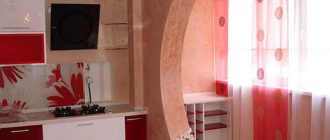
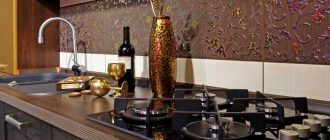
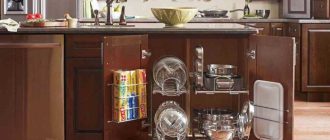
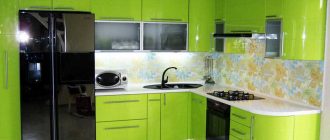
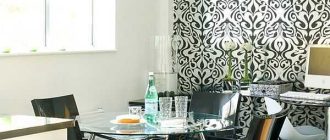
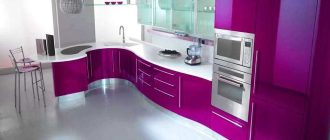
Escolher os acabamentos para as paredes da cozinha é algo que muda tudo! Optei por azulejos de metro e ficam fantásticos com o meu esquema de cores. Dá um toque especial ao ambiente! Mal posso esperar para cozinhar e mostrá-la aos amigos. A sério, vocês vão adorar!